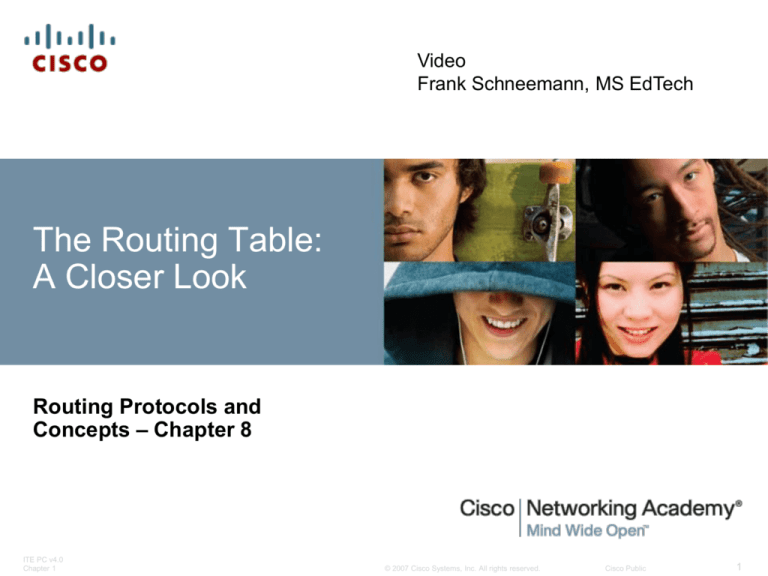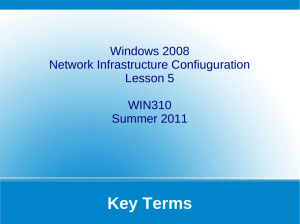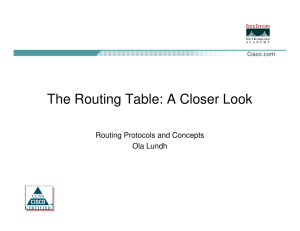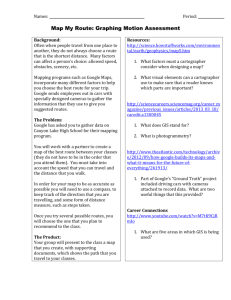
Video
Frank Schneemann, MS EdTech
The Routing Table:
A Closer Look
Routing Protocols and
Concepts – Chapter 8
ITE PC v4.0
Chapter 1
© 2007 Cisco Systems, Inc. All rights reserved.
Cisco Public
1
8.0.1 Chapter Introduction
OBJECTIVES
• Describe the various route types found in the routing
table structure
• Describe the routing table lookup process.
• Describe routing behavior in routed networks.
Chapter Focus
-Structure of the routing table
-Lookup process of the routing table
-Classless and classful routing behaviors
8.0.1 Chapter Introduction
8.1.1 Lab Topology
8.1.1 Lab Topology
8.1.2 Routing Table Entries
Routing table entries come from the following sources
• -Directly connected networks
• -Static routes
• -Dynamic routing protocols
8.1.3 Level 1 Routes
Level 1 Routes
• As soon as the no shutdown command is issued the route is added
to routing table which can be observed with the debug command
8.1.3 Level 1 Routes
Cisco IP routing
table is a
hierarchical
structure
The reason for this
is to speed up
lookup process
8.1.3 Level 1 Routes
A level 1 route is a route with a subnet mask equal to or less than the
classful mask of the network address. 192.168.1.0/24 is a level 1
network route, because the subnet mask is equal to the network's
classful mask. /24 is the classful mask for class C networks, such as
the 192.168.1.0 network.
A level 1 route can function as a:
• Default route - A default route is a static route with the address
0.0.0.0/0.
• Supernet route - A supernet route is a network address with a mask
less than the classful mask.
• Network route - A network route is a route that has a subnet mask
equal to that of the classful mask. A network route can also be a
parent route. Parent routes will be discussed in the next section.
The source of the level 1 route can be a directly connected network,
static route, or a dynamic routing protocol.
8.1.3 Level 1 Routes
Level 1 Routes
-Have a subnet mask equal to or less than the classful mask of the
network address.
Level 1 route can function as
• -Default route
• -Supernet route
• -Network route
8.1.3 Level 1 Routes
Level 1 Routes
• Ultimate Route
• Includes either:
-A next-hop address
or
-An exit interface
The directly connected network
192.168.1.0/24 is a level 1 network route
because it has a subnet mask that is the
same as its classful mask. This same
route is also an ultimate route because it
contains the exit interface Serial 0/0/1.
8.1.4 Parent and Child Routes: Classful Networks
• Parent and Child
Routes
-A parent route is a
level 1 route
-A parent route does
not contain any nexthop IP address or exit
interface information
8.1.4 Parent and Child Routes: Classful Networks
A level 1 parent route is a network route that does not contain a next-hop IP
address or exit interface for any network. A parent route is actually a
heading that indicates the presence of level 2 routes, also known as child
routes.
8.1.4 Parent and Child Routes: Classful Networks
Automatic creation of parent routes
• Occurs any time a subnet is added to the routing table
• Child routes
-Child routes are level 2 routes
-Child routes are a subnet of a classful network address
8.1.4 Parent and Child Routes: Classful Networks
Level 2 child routes contain route source & the network address of the route
Level 2 child routes are also considered ultimate routes
Reason: they contain the next hop address &/or exit interface
8.1.4 Parent and Child Routes: Classful Networks
Both child routes have the same subnet mask
-This means the parent route maintains the /24 mask
8.1.4 Parent and Child Routes: Classful Networks
If both child
routes are
removed the
parent route
will be deleted
Diagram illustrates 2 child networks belonging to the
parent route 172.16.0.0 / 24
8.1.5 Parent and child Routes: Classless Networks
In classless networks, child routes do not have to share
the same subnet mask
8.1.5 Parent and child Routes: Classless Networks
Network
Type
Parent route’s
Classful mask is
Displayed
Term
variably
subnetted
is seen in parent
route in routing
table
Classful
No
No
No
No
Classless
Yes
Yes
Yes
Yes
Includes the Subnet mask
# of different
included
masks of
with each
child routes
child route
entry
8.1.5 Parent and child Routes: Classless Networks
8.2.1 Steps in the Route Lookup Process
In this topology, RIPv1, a classful
routing protocol, is now configured.
Notice that we have specifically
chosen a classful routing protocol
with our discontiguous 172.16.0.0
subnets.
8.2.1 Steps in the Route Lookup Process
As you would expect with this
addressing scheme and a
classful routing protocol, there
are reachability problems.
Neither R1 nor R2 has a route
to 172.16.4.0. Also, R3 does
not have routes to subnets
172.16.1.0/24, 172.16.2.0/24,
or 172.16.3.0/24.
8.2.1 Steps in the Route Lookup Process
The Route Lookup Process
Examine level 1 routes
-If best match is a level 1 ultimate route and is not a parent
route this route is used to forward packet
Router examines level 2 (child) routes
-If there is a match with level 2 child route then
that subnet is used to forward packet
-If no match then
determine routing behavior type
Router determines classful or classless routing behavior
-If classful then
packet is dropped
-If classless then router searches level one supernet and
default routes
-If there exists a level 1 supernet or default route match
then Packet is forwarded. If not packet is dropped
8.2.1 Steps in the Route Lookup Process
Your curriculum contains a nice graphic that will take you, step by step, through the
Route Lookup Process. Check it out.
8.2.2 Longest Match – Level 1 Network Routes
Longest Match: Level 1 Network Routes
–Best match is also known as the longest match
–The best match is the one that has the most number of left
most bits matching between the destination IP address and
the route in the routing table.
8.2.2 Longest Match – Level 1 Network Routes
For example, in the figure we have a packet destined for 172.16.0.10.
Many possible routes could match this packet. Three possible routes are
shown that do match this packet: 172.16.0.0/12, 172.16.0.0/18, and
172.16.0.0/26. Of the three routes, 172.16.0.0/26 has the longest match.
Remember, for any of these routes to be considered a match there must
be at least the number of matching bits indicated by the subnet mask of
the route.
8.2.2 Longest Match: Level 1 Network Routes
Finding the subnet mask used to determine the longest match
Scenario:
–PC1 pings 192.168.1.2
–Router examines level 1 route for best match
–There exist a match between192.168.1.2 & 192.168.1.0 / 24
–Router forwards packets out s0/0/0
8.2.2 Longest Match: Level 1 Network Routes
The process of matching
-1st there must be a match made between the parent route & destination IP
-If a match is made then an attempt at finding a match between the
destination IP and the child route is made.
8.2.2 Longest Match: Level 1 Network Routes
There may be multiple potential routes with different subnet masks in the
routing table for the same destination IP address. The one with the most
number of matching bits, the longest match, is preferred.
-The figure shows a match between the destination IP of 192.168.1.0 and
the level one IP of 192.168.1.0 / 24 - the packet forwarded out s0/0/0
8.23 Longest Match: Level 1 Parent and Level 2 Child Routes
Level 1 Parent & Level 2 Child Routes
A parent route does not include a next-hop address or an exit
interface but is only a "header" for its level 2 child routes, the
subnets
Before level 2 child routes are examined There must be a
match between classful level one parent route and destination
IP address.
8.23 Longest Match: Level 1 Parent and Level 2 Child Routes
After the match
with parent
route has been
made Level 2
child routes will
be examined
for a match
Route lookup
process
searches for
child routes
with a match
with destination
IP of at least 24
bits
8.23 Longest Match: Level 1 Parent and Level 2 Child Routes
How a router finds a match with one of the level 2 child routes
-First router examines parent routes for a match
-If a match exists then:
Child routes are examined
Child route chosen is the one with the longest match
8.23 Longest Match: Level 1 Parent and Level 2 Child Routes
Example: Route
Lookup Process
with VLSM
The use of
VLSM does not
change the
lookup process
If there is a
match between
destination IP
address and
the level 1
parent route
then
Level 2 child
routes will be
searched
8.3.1 Classful and Classless Routing Behavior
Classful & classless routing protocols
Influence how routing table is populated
Classful & classless routing behaviors
Determines how routing table is searched after it is filled
8.3.1 Classful and Classless Routing Behavior
8.3.1 Classful and Classless Routing Behavior
8.3.2 Classful Routing Behavior: no ip classless
What happens if there is not a match with any level 2 child routes of the
parent?
-Router must determine if the routing behavior is classless or classful
-If router is utilizing classful routing behavior then Lookup process is
terminated and packet is dropped
8.3.2 Classful Routing Behavior: no ip classless
The command no ip classless means that the route lookup process uses classful
routing table lookups by default. This will be explained in the following sections.
The commands no ip classless and ip classless are global configuration
commands and can be viewed by typing show running-config. In IOS versions
11.3 and later, the command ip classless is the default, implementing a classless
route lookup process.
What is the effect of classful routing behavior when all the routers are configured
with the no ip classless command?
R1(config)#no ip classless R2(config)#no ip classless R3(config)#no ip classless
8.3.3 Classful Routing Behavior – Search Process
In this example, R2
receives a packet
destined for PC3 at
172.16.4.10.
When classful routing behavior is in effect (no ip classless) the process
will not continue searching level 1 routes in the routing table. If a packet
doesn't match a child route for the parent network route, then the router
drops the packet.
8.3.3 Classful Routing Behavior – Search Process
None of the 24 left-most bits of the child routes matches the
destination IP address of 172.16.4.10. At most, only 21 bits match.
There is no match with the level 2 child routes.
8.3.3 Classful Routing Behavior – Search Process
8.3.4 Classless Routing Behavior: ip classless
Classless or
classful?
If Classful, terminate the
lookup and drop the
packet
in Steps 1 and 2, the routing table process examines level 1 and level 2 child
routes looking for the best match with the IP packet's destination address. Let's
assume there is no match and resume the route lookup process
The Route Lookup Process:
Is the router implementing classful or classless routing behavior?
Classful routing behavior:
If classful routing behavior is in effect, terminate the lookup process and drop the
packet.
8.3.4 Classless Routing Behavior: ip classless
Classless routing behavior: If classless routing behavior is in effect, continue
searching level 1 supernet routes in the routing table for a match, including the
default route, if there is one.
If there is now a lesser match with a level 1 supernet or default routes, the router
uses that route to forward the packet.
If there is not a match with any route in the routing table, the router drops the
packet.
8.3.5 Classless Routing Behavior – The Search Process
What happens when
classless routing behavior
(ip classless) is in effect?
Again, R2 receives a packet
destined for PC3 at 172.16.4.10.
8.3.5 Classless Routing Behavior – The Search Process
Just as it did with the classful routing behavior, the router searches the routing
table and finds a 16-bit match with the parent route 172.16.0.0, as shown in the
figure. According to Step1b of the routing process, if there is a match with a parent
route, then the child routes are checked.
8.3.5 Classless Routing Behavior – The Search Process
As before, none of the 24 left-most bits of the child routes matches the
destination IP address of 172.16.4.10. At most, only 21 bits match. There is
no match with the level 2 child routes.
Because we are using classless routing behavior (ip classless), the router
continues searching the routing table, beyond this parent route and its child
routes. The routing process will continue to search the routing table for a
route with a subnet mask fewer than the 16 bits of the previous parent route.
In other words, the router will now continue to search the other routes in the
routing table where there may be fewer bits that match, but still a match.
8.3.5 Classless Routing Behavior – The Search Process
The 192.168.1.0/24 route does not have 24 left-most bits that match the destination
IP address.
C 192.168.1.0/24 is directly connected, Serial0/0/1
8.3.5 Classless Routing Behavior – The Search Process
How about the default route? How many bits need to match?
S* 0.0.0.0/0 is directly connected, Serial0/0/1
The mask is /0, which means that zero or no bits need to match. A default route will
be the lowest-bit match. In classless routing behavior, if no other route matches,
the default route will match.
8.3.5 Classless Routing Behavior – The Search Process
In this case the router will use the default route, because it is the best
match. The packet will be forwarded out the Serial 0/0/1 interface.
Classful Route on R3
8.3.5 Classless Routing Behavior – The Search Process
8.3.5 Classless Routing Behavior – The Search Process
Classful vs. Classless Routing Behavior in the Real World
8.4.1 Investigating the Routing Table Lookup Process
In this lab, you will be able to investigate classless and classful routing
behavior.
In this Packet Tracer activity, you will be able to investigate classless and classful
routing behavior.
8.4.2 Show IP Route Challenge Lab
In this lab activity, you will determine the topology of a network using the outputs
from the show ip route command. You must draw a topology diagram and
determine the interface addressing on each router. Then you must build and
configure the network based on the outputs. The DTE and DCE assignment is at
your discretion. When complete, the outputs from your network must match those
given below.
In this lab activity, you will determine the topology of a network using the outputs
from the show ip route command.
8.5.1 Summary and Review
8.5.1 Summary and Review
Understanding the structure and lookup process of the routing table can
be an important tool in verifying and troubleshooting networks. Knowing
which routes should be included and which routes should not be included
in the routing table is a critical skill when troubleshooting routing issues.
The Cisco IP routing table is structured in a classful manner, which means
that it uses to the default, classful addresses, to organize the route
entries. The source of a routing entry can be a directly connected network,
static route, or a route learned dynamically from a routing protocol.
In this chapter, you learned that there are level 1 and level 2 routes. A
level 1 route can be either an ultimate route or a parent route. A level 1
ultimate route is a route with a subnet mask equal to, or less than the
default classful mask of the network; and either a next hop address or an
exit interface. For example, a route learned through RIP with the network
address of 192.168.1.0 and a /24 network mask is a level 1 ultimate route.
These routes are displayed in the routing table as a single route entry,
such as:
R 192.168.1.0/24 [120/1] via 172.16.2.2, 00:00:25, Serial0/0/0
8.5.1 Summary and Review
Another type of level 1 route is a parent route. A level 1 parent route is automatically
created when a subnet route is added to the routing table. The subnet route is
known as a level 2 child route. The parent route is a header for level 2 child routes.
Here is an example of a level 1 parent route and a level 2 child route:
172.16.0.0/24 is subnetted, 1 subnets
R 172.16.1.0 [120/1] via 172.16.2.1, 00:00:07, Serial0/0/0
The subnet mask of the child routes are displayed in the parent route unless VLSM
is used. With VLSM, the parent route displays the default classful mask and the
subnet mask is included with the individual VLSM route entries.
You were also introduced to the routing table lookup process in this chapter. When a
packet is received by the router, it looks for the longest match with one of the routes
in the routing table. The longest match is the route with the largest number of leftmost bits that match between the destination IP address of the packet and the
network address of the route in the routing table. The subnet mask associated with
the network address in the routing table defines the minimum number of bits that
must match for that route to be a match.
8.5.1 Summary and Review
Before examining any level 2 child routes (subnets) for a match there must first be a
match with the level 1 parent route. The classful mask of the parent determines how
many bits must match the parent route. If there is a match with the parent route,
then the child routes will be searched for a match.
What happens when there is a match with the parent route but none of the child
routes? If the router is using classful routing behavior, no other routes will be
searched and the packet will be discarded. Classful routing behavior was the default
routing behavior on Cisco routers prior to IOS 11.3. Classful routing behavior can be
implemented using the no ip classless command.
8.5.1 Summary and Review
Starting with IOS 11.3 classless routing behavior became the default. If there is a
match with a parent route but none of the child routes, the routing table process
will continue to search other routes in the routing table including a default route
should one exist. Classless routing behavior is implemented by using the ip
classless command.
Routes to networks get added to the routing table from various sources including
directly connected networks, static routes, classful routing protocols and classless
routing protocols. The lookup process, classful or classless routing behavior, is
independent of the source of the route. A routing table may have routes learned
from a classful routing protocol such as RIPv1, but uses classless routing
behavior, no ip classless, for the lookup process
8.5.1 Summary and Review
8.5.1 Summary and Review







